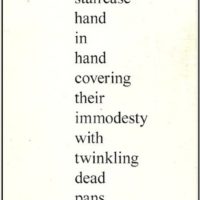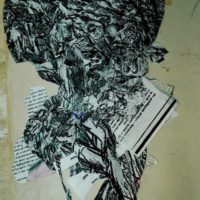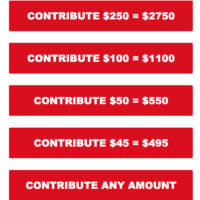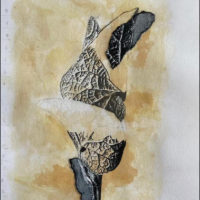Brad Spurgeon memorializes him: “End of an Era, but not of a Philosophy of Life.” I never met Jim. But he was extraordinarily welcoming when we corresponded by email about the strange case of Orwell’s typewriter.
Remember These Headlines
These headline writers got it right.
GC CUNY at the Center of the Conversation
Peter Baker & Susan Glasser on James A. Baker III, with Kai Bird
“For a quarter-century, from the end of Watergate to the aftermath of the Cold War, no Republican won the presidency without the help of James A. Baker III or ran the White House without his advice. Now two major political journalists, Peter Baker (of The New York Times) and Susan Glasser (of The New Yorker) have written ‘The Man Who Ran Washington,’ a definitive, page-turning biography of the power broker whose impact was unmatched when Washington ran the world and who influenced America’s destiny for generations. The authors join in a discussion with Kai Bird, executive director of the Leon Levy Center for Biography.”
Let’s Begin the New Year . . .
. . . with an old poem by a late friend: “buster / duchamp / and / marcel / keaton / walked / down / an / exploding / staircase / hand / in / hand / covering / their / immodesty / with / twinkling / dead / pans / did / marcel / keaton / and buster / duchamp”
Heathcote Williams: ‘Cobalt Blues’
I was reminded of ‘Cobalt Blues’ this morning by Louise Erdrich’s op-ed “Not Just Another Pipeline” about “a tar sands climate bomb” in Minnesota now under construction and racing “to lock in pipeline infrastructure” before it can be stopped.
‘Burroughs and the Dharma’
William S. Burroughs was not a Buddhist: he never sought or found a “Teacher,” he never took Refuge, and he never undertook any Bodhisattva vows nor—for that matter—did he ever declare himself a follower of any one faith or practice.. He did not consider himself a Buddhist. But he did have an awareness of the essentials of Buddhism, and in his own way, he was affected by bodhidharma.
Twin Engines of Misrule
Sometimes my tireless staff of thousands looks back and sees a blogpost that demands to be reposted. This one from Dec. 17, 2004 — 18 years ago next week, imagine that: “When 1984 came around smack in the middle of the rose-tinted Reagan era, many in the commentariat had a field day noting that George Orwell, for all his genius, had overstated his case. The future he’d warned of in ‘1984’ simply hadn’t come to pass.”
On Account of the Pandemic . . .
VACCINE: It’s not a matter / of knowing we will end— / though it’s no fun, / that is not the matter— / everything will end. / The matter is, / there’s no cure for that. / When death is deleted / by coding—digital, / genetical, biochemical— / whatever combination / it takes—something else / will provoke us. Freud / thought it perpetual.
GC CUNY at the Center of the Conversation
Biden Chronicler Evan Osnos on the 2020 Presidential Election
In his new book, “Joe Biden: The Life, the Run, and What Matters Now,” Evan Osnos draws on nearly a decade of reporting for The New Yorker. His portrait of Biden and what his election means for the nation. is based on lengthy interviews with Biden, as well as conversations with President Barack Obama, the Biden family, his advisers, rivals, and opponents.
Pandemic Poems From Cold Turkey Press: Mistress Death
This handmade, 16-page chapbook is not about Covid-19, but the virus is present in every line.
The Clown King’s Latest Confidence Game
An email arrived just in tiime for Thanksgiving, asking for contributions to help overturn the election even after he’s been declared—signed, sealed, and certified—the absolute loser. Meanwhile construction has begun on renovations to his post-presidential living quarters in Florida. Does he believe his supporters are brain-dead suckers? Of course.
The Holy Grail of the Beat Generation
Neal Cassady: ‘The Joan Anderson Letter’
When Jack Kerouac read Neal Cassady’s spontaneous rush of words, he claimed it was more alive than any piece of writing he had ever seen. In its effusive style, its freewheeling candor, its Proustian (yes, Proustian!) introspection, the letter touched off a response in Kerouac that reshaped entirely his own approach to writing. The result was an explosion of “road” novels, beginning with “On the Road,” in which Cassady is renamed Dean Moriarity and seen as nothing less than “the root, the soul” of Beat legend.
REDUX: The Shithole and the Shithouse
Originally posted Jan. 17, 2018. By now many, many millions of people have seen the rebranded Trump International Hotel in Washington, D.C. Or if they haven’t, at least that many have googled it. If you’re the one person who hasn’t seen it, here it is. And here, not incidentally, is Trump’s Shithouse in Washington D.C., also known as The White House.
His Birthday Was 79 Years Ago Today
Heathcote Williams was an unstoppable force. Even in death he is unstoppable. His writings, his activism, and his personal example continue to inspire others. At heart, Williams was a revolutionary. The historian Peter Whitfield placed his work in a “great tradition of visionary dissent” stretching from William Blake and John Ruskin to DH Lawrence and David Jones. I had the privilege of recording Williams’s final vinyl LP-cum-CD, “American Porn,” at his home in Oxford several years before he died. The poems he read — “Mr. President,” “The United States of Porn,” “Forbidden Fruit, or The Cybernetic Apple Core,” and “Snuff Films at the White House” — were in their uncompromising nakedness CT scans of history.
Another Lesson in the Art of Drawing
We’ve been following Amélie, a talented, 14-year-old student artist whose drawing has shown impressive skill. The last time she was asked to copy a sketch by Daumier. The point of that exercise was to shape the forms through the tonal value of the lines rather than outlining them with a fixed line. The idea was to develop the contours of the forms through the process of drawing. This time she was asked to draw an object as part of a study of natural forms.
Thanks to Covid-19, We Know Her Better Than Before
“She’s a city-dwelling, / sagely bearded / mountain man, / a libidinous old dame / dressed in evening wear. / Her eyes are hooded . . . / Into this zone of mirth / our mistress of endings / sends the world spinning / out of orbit.”
GC CUNY at the Center of the Conversation
Peniel E. Joseph on MLK and MALCOLM X
with David Levering Lewis
“To most Americans, Malcolm X and Martin Luther King Jr. represent contrasting ideals: self-defense vs. nonviolence, black power vs. civil rights, the sword vs. the shield. Peniel E. Joseph’s dual biography of Malcolm X and Martin Luther King, ‘The Sword and the Shield,’ upends longstanding preconceptions to transform the understanding of the twentieth century’s most iconic African American leaders.” — GC Presents / The Center for Humanities














![Heathcote Williams [Photo: JH, 2013]](https://www.artsjournal.com/herman/wp/wp-content/uploads/2017/07/heathcote-williams-photo-copy-200x200.png)

